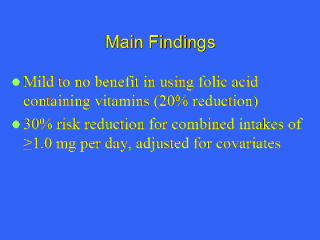| front |1 |2 |3 |4 |5 |6 |7 |8 |9 |10 |11 |12 |13 |14 |15 |16 |17 |18 |19 |20 |21 |22 |23 |24 |25 |26 |27 |28 |29 |30 |31 |32 |33 |34 |review |
 |
- The
fact that so few Mexican American women in this study consumed multivitamins during the
critical time period severely limited what could be determined about supplemental folic
acid and NTD risk in this population - Combining the estimated folic intakes from supplements and dietary sources did not reveal any strong effects - Our findings are consonant with Shaw 1995 who also showed modest effects for combined sources (20% - 40%) - The risk reductions for Hispanics contrast sharply with the much greater reductions seen among non-Hispanic White women at the same levels (in the Shaw study) - The modest effects of combined intakes are probably due to the intake ratios of dietary folate to supplemental folic acid - Hispanic women receive a smaller proportion of the bioavailable form (folic acid) than other women |